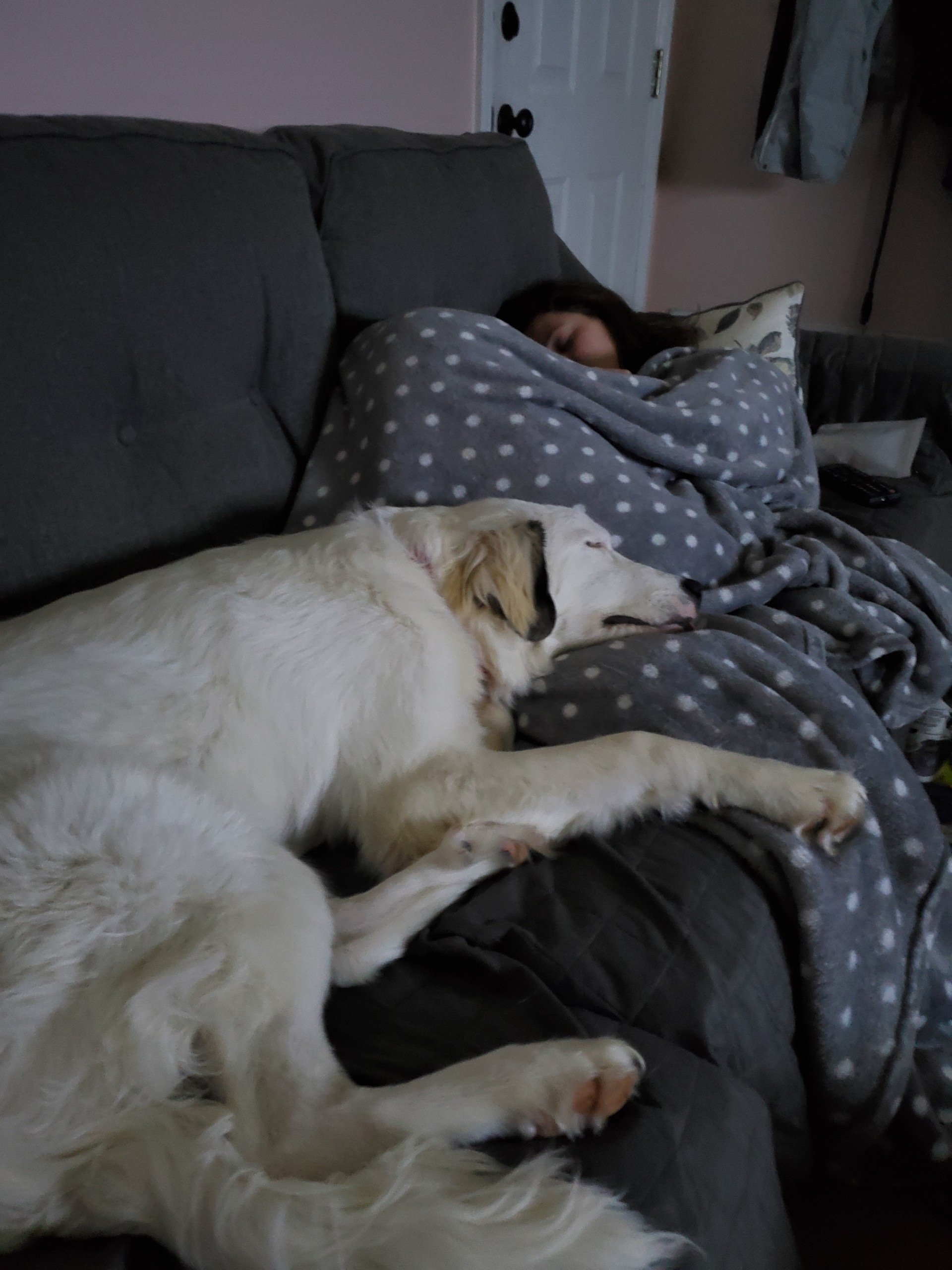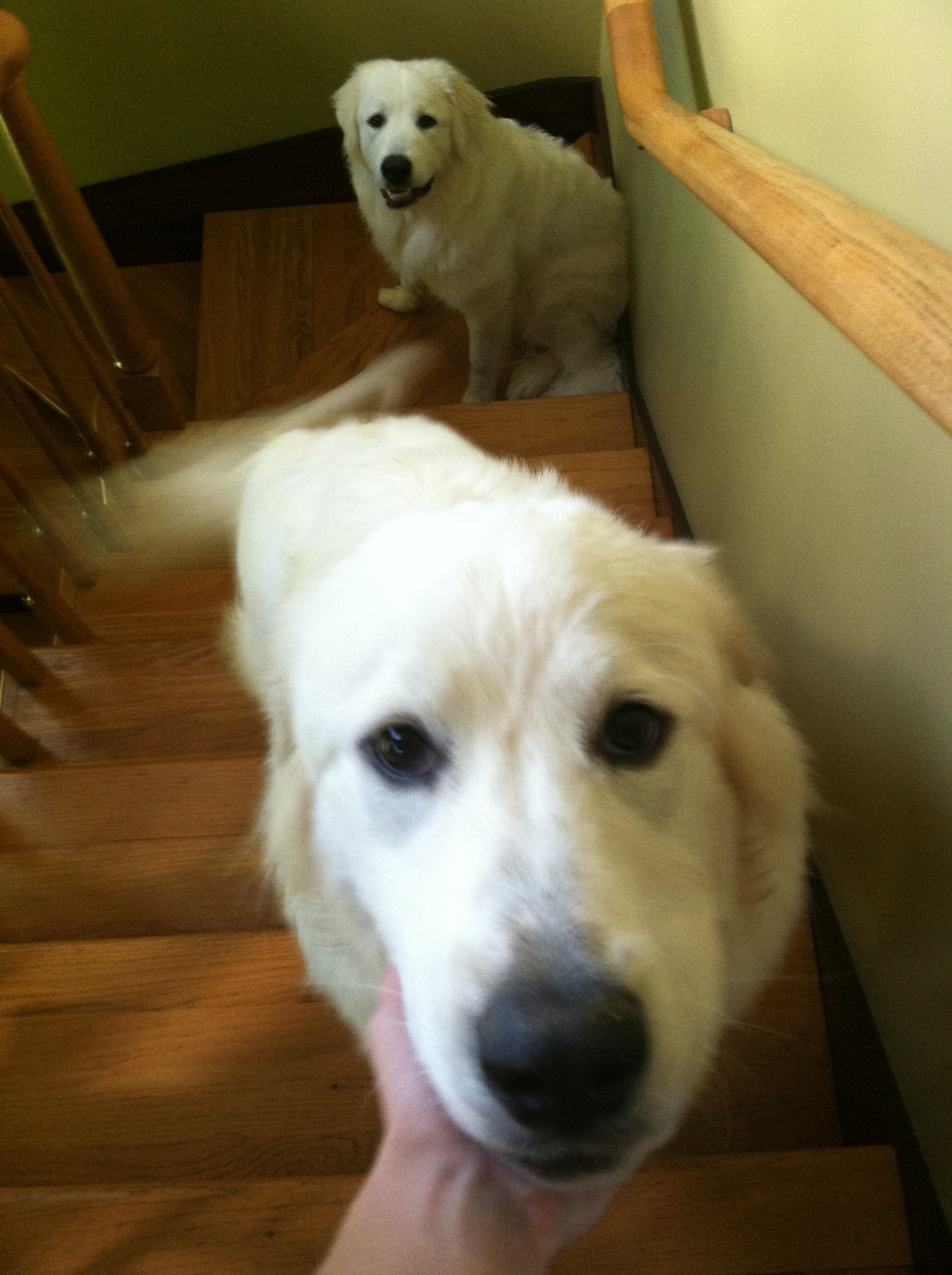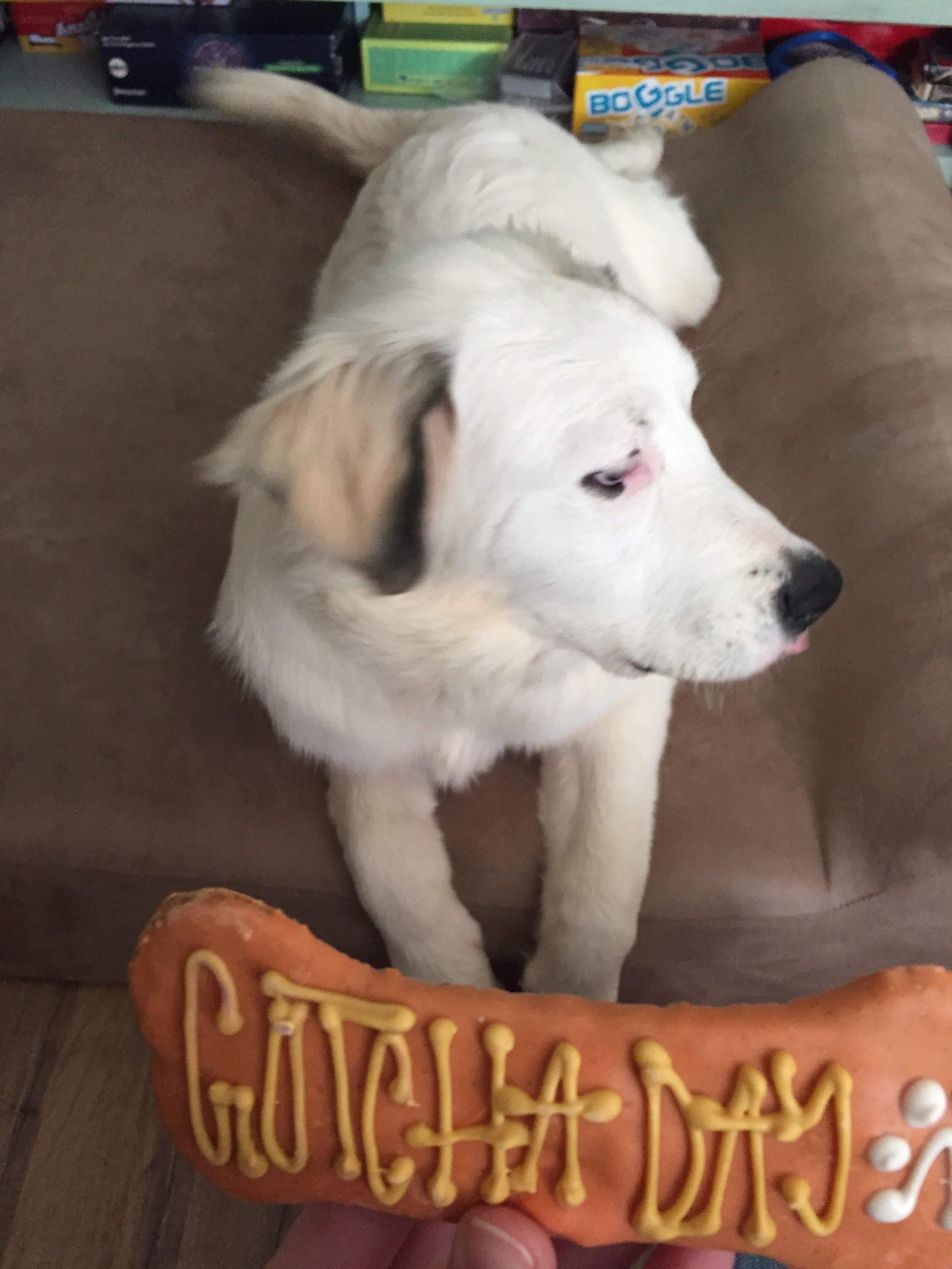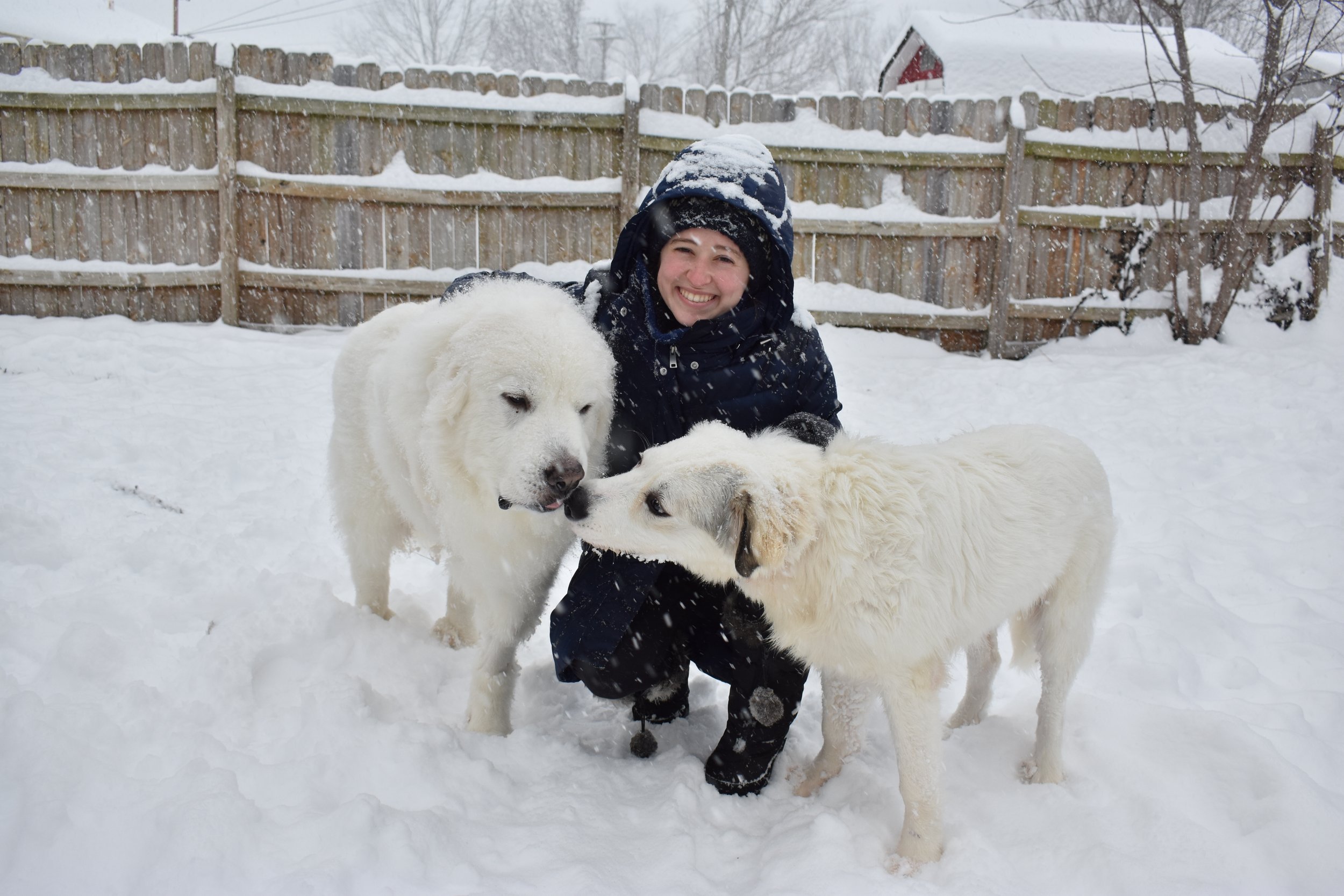7 Things to Know Before Getting a Great Pyrenees (& an introduction to Winnie)
If you’ve been a longtime follower of the blog, you’ll know I’m a self-proclaimed Great Pyrenees enthusiast. However, the last time I wrote a Great-Pyrenees-centered post was way back in 2018. In the interim years, a lot has happened, including learning way more about what it’s like to own a Great Pyrenees by going through the adoption process for another Pyr puppy this past October.
Firstly, some introductions are in order. I currently have two Great Pyrenees. This is Winnie:
Winnie is a 13-month-old Great Pyrenees mix (7.5% Lab, 5.4% Rottweiler). We adopted her when she was about 4 months old this past October through the National Great Pyrenees Rescue Society. For us, it was a largely positive experience (although we did run into the issue of wanting a particular puppy and being worried about her being adopted to someone else because our application approval was delayed by interview scheduling).
Winnie is rambunctious and energetic. More energetic than our other Pyrs were at her age. She will go on long hikes with us, loves the dog park, and goes crazy playing with toys (aka destroying toys). She really loves eating sticks and grass (even when we try to stop her). She’s very much a dog’s dog—unlike our other Pyrs, who are/were stuck to our sides, Winnie is stuck to any dog who comes into our house. She’s very attached to Argos, our other Pyr; when she’s scared or sad, he’s about the only one who can make her feel at ease.
Our other Pyr is Argos:
He’s an 8-year-old purebred Great Pyrenees. He was one of our family dogs, and I inherited him. We brought him and his sister (not by blood) Luna home when they were about 8 weeks old. As you might be able to see in the last picture, he only has three legs, as he had one amputated in November due to osteosarcoma in his right ankle. Argos is a big goofy boy who just wants to lay on your lap all day (until he overheats, of course). He’s always loved playing, and ever since he was a puppy (see above), his favorite thing has been to roll around on his back, biting at his playmate.
Luna was our other Great Pyrenees, whom we lost in August of 2021 to osteosarcoma. She was more independent than Argos, but she loved pets and would guide your hand to pet her by gently grabbing it with her mouth. She had a big voice and would bark all night long if she could.
So, without further ado, from a Pyr-owner since 2013, I’d like to share my wisdom for anyone out there thinking about getting a Great Pyrenees or who just adopted one and is wondering what they got themselves into.
1 . Great Pyrenees have a high rate of ending up in shelters. So you should highly consider adopting before looking into breeders.
There are a few reasons why Pyrs are often found in shelters: first, they are LGDs (livestock guardian dogs), meaning they have been bred to protect livestock from predators. However, they require training to perform this job and cannot be left alone with livestock until they are fully mature at 2 years old. Many people get a Pyr puppy thinking they can handle this job right away and end up turning it over to a shelter when it fails its role and kills some chickens or chases some goats.
Second, an off-leash Pyr is a disa-pyr. Great Pyrenees are roaming dogs who need an established territory. If you don’t have a tall fence (at least 5 ft), they will leave and not come back. At our childhood home, we had a horse fence that they squeezed themselves under sometimes, and we’d have to chase them down (it was not fun). People get scared of Great Pyrenees, and they’ll shoot at them.
Third, Great Pyrenees are a lot of maintenance. They require special grooming, make you vacuum your house every other day, have high vet bills, and need obedience training to ensure they’re the “gentle giants” you hear so much about. Many end up having to rehome them due to having children, moving to an apartment, or just being unable to deal with the demands of the breed.
When we were looking to adopt this past fall, we saw many Great Pyrenees at our surrounding shelters, from puppies to seniors. You can also look at larger Pyr rescue organizations like National Great Pyrenees Rescue Society, where we adopted Winnie. These Pyr-specific rescues do a lot of work to ensure that Pyrs end up in homes that are equipped to love and care for this breed with all its quirks and flaws.
2. They are prone to certain health problems, which result in giant vet bills.
Giant breed dogs are more prone to certain health problems, and the bigger the dog, usually the higher the vet bill. One thing that you should know about getting a Great Pyrenees puppy is that more recent veterinarian advice has been to wait until after at least a year (two if possible) to spay/neuter giant breed dogs in order to allow their bones to fully develop and lessen the risk of osteosarcoma. While spaying/neutering a 6-month-old Chihuahua might only cost you $100, it may cost you upwards of $500 to spay/neuter a 1-year-old Pyr. Low-cost spay/neuter clinics may not be a good option if you have any doubts about their experience with giant breed dogs like Pyrs, who have a slow metabolism and handle anesthesia differently than other dogs.
Our Pyrs have had two major health problems: the first is hip dysplasia, which is very common in Pyrs. Luna was diagnosed when she was around 3 or 4 years old, and the first signs were bunny-hopping with her back legs and limping after rough play. We managed it with supplements and pain medication, but if she’d lived longer, she may have needed major surgery. The second major health problem is, of course, osteosarcoma, or bone cancer. Luna passed from this in August of 2021, three months post-diagnosis, and Argos was diagnosed in November of 2021. It’s a common cancer in Pyrs, and if you opt for treatment, as we did, it will cost you thousands of dollars.
I would also consider that it’s much harder to look after a giant dog when they need major medical intervention. This might be common sense, but it’s something I’d never thought of before. When Luna had trouble walking after her surgery, we had to carry her. Physically, I couldn’t do that alone. I couldn’t force her to come inside when she didn’t want to, despite it being too hot for her, and I couldn’t always get her to walk into the vet’s office. It’s also harder to stop them from moving around. After Argos’ surgery, he immediately wanted to get back to normal and jump up on the couch. I couldn’t hold him down, and he ended up popping a stitch and drowning our couch in blood.
When I was looking at the adoption fees at NGPR ($400-$650) and comparing them to the adoption fees at local shelters ($50-$150), I was shocked. But upon reading their explanation, I completely get it: if you aren’t prepared to invest that much money in a Pyr, you probably aren’t prepared for the expenses of owning a giant breed dog.
3. They are not labs. They will obey you if they think that’s the best decision for them in the moment.
There are some breeders that have been selling Great Pyrenees puppies under the name of a much more expensive breed: the English cream golden retriever. Pyrs are NOT golden retrievers or labs. They are (sometimes) bigger, shed more, bark more, and obey less. Labs and Goldens have this innate desire to please you. Not so with the Pyr. Great Pyrenees were bred to make decisions independently—they need to be able to work alone, without a person there telling them what to do. Whenever I ask my Pyrs to do something, I can see them consider whether they will obey me first. Anecdotally, our male Pyr is more obedient than our female Pyrs.
Now, this doesn’t mean you shouldn’t train your Pyr. In fact, it’s EXTRA important to train a Pyr. They are large dogs that can overpower you if you’re not careful. Getting them obedience training will help you build a stronger bond and curb certain bad behaviors. We took Winnie to obedience training this spring at around 9 months old, after having already taught her some basic commands at home, and she was a quick learner. However, we had to make peace with the fact that sometimes she would refuse to do a command for us multiple times and then choose to do it for the trainer the first time she asked.
I would also think again if you believe you can “obedience train” barking out of this breed. There are mitigation tactics, but barking is in their DNA. They use it to scare off intruders (including the leaf blowing through the yard outside). You can try acknowledging them when they bark, shutting blinds, turning on white noise, keeping to a strict nighttime routine that tells them when it’s time to sleep, crating them at night, or letting them sleep somewhere they can see you (and thus know you’re alive despite the menacing of said leaf). However, expect varied results. Luna barked no matter what at all times of the day and night. Argos will stop barking if you acknowledge him, and he doesn’t bark at night if he sleeps in our room. Winnie, miraculously, has not yet started barking and we crate her at night, so we’ll have to see if that holds true as she gets older.
4. They shed twice a year for six months.
Great Pyrenees are double-coated, meaning they have an undercoat that’s soft and dense and an outer coat that’s more coarse. This undercoat keeps them insulated, meaning, like a thermos, they can be kept hot or cool depending on the temperature outside. You should NEVER shave a Great Pyrenees unless their coat is severely matted, as it will not cool them down and will actually put them at risk of sunburn and heat stroke.
As far as maintenance goes, you should be brushing a typical Pyr at least once a week (and vacuuming at least twice a week). When they’re young, you need to teach them to enjoy brushing by rewarding interactions with the brush and desensitizing them to grooming sessions with praise and treats. Do the same with nail trims (and use heavy duty nail clippers). If you are consistent with this, your Pyrs will be like mine and just lay there, unbothered, to get their weekly brush and nail trim. We use a double-sided de-matting comb that looks like this. We do also have a Furminator; however, I don’t like it, as I feel it yanks out their hair.
Brushing or combing regularly is not optional. If you don’t do this, they will develop mats QUICKLY. These mats pull at their skin, causing hair loss and skin irritation, even infections.
If you’re scared by the prospect of combing out literal mountains of fur and vacuuming up snow drifts in every corner of your home, you might consider looking for a Great Pyrenees mix that has a shorter and smoother coat. I’ve found that Winnie, whose hair texture is smooth and not fluffy like Argos’, sheds significantly less and her fur is less prone to mats. Regardless, there is one good thing about Pyr fur: it magically repels dirt! So you’ll only need to bathe them every 3-6 months if they’re indoors.
5. Food might be a little. . .complicated.
Pyrs are weirdos when it comes to food. They can often be picky eaters and have sensitive stomachs. Due to their low metabolism, low energy, and independent thinking, they usually don’t need the recommended amount of food on the bag and are tough to keep on a schedule. Some of them are experts at self-regulation and will only eat when they know they need to (aka when they’ve actually used some energy for more than sleeping around the house). This is Winnie—she will eat four cups of her large breed puppy food every day she’s at boarding, where she’s playing with other dogs all day every day, then she’ll go to one or two cups a day when she’s just lazing the day away at home and only going on her two to three normal walks.
The other big issue with food and Pyrs is resource guarding. Resource guarding is when an animal gets possessive over a resource (like food, toys, a bone, etc.) and will get aggressive when it thinks you are going to take it away. When Luna and Argos were puppies, we free fed them, which is supposed to help prevent resource guarding, as the dogs are meant to feel that they are never in danger of losing access to food. However, this backfired for two reasons: one, Luna and Argos were not good self-regulators like Winnie, and they became overweight, and two, Luna would just lay beside and guard the food bowls, preventing Argos from eating unless we were there to keep them separated. To prevent resource guarding in Argos, we feed all the animals separately, and we always keep Winnie separated from him whenever he has bones or high value treats. To keep ourselves safe, we trade for his bones/antlers (exchange a smaller treat for them), though he’s never shown resource guarding tendencies with his humans.
It’s very important to keep Pyrs at a healthy weight because of their tendency to have hip dysplasia and heart problems. While some Pyrs will get up to 150 lbs, a lot of Pyrs are much smaller than this. You should never overfeed your Pyr to try to get it to reach a larger weight than is healthy for its frame. Ours have varied; Luna was 95-100 lbs, Argos was 110, but is now around 100 after he lost his leg, and Winnie is about 80 lbs (though maybe not full grown, as they don’t stop growing until 2 years old).
Another important thing to remember about food is that as puppies, large and giant breed dogs need specially formulated food that has specific amounts of calcium to ensure their bones grow at the correct rate. We have a very picky eater in Winnie, so we’ve tried Diamond Naturals Large Breed Puppy in lamb and rice, Blue Buffalo Large Breed puppy in chicken (her least favorite), and Purina Pro Plan Large Breed Puppy in chicken (her current food).
The last thing you should know about food (and this applies to all dogs, but especially large and giant breeds) is that grain-free dog foods are potentially linked to dilated cardiomyopathy. This is a heart problem that large and giant breeds are already predisposed to. Anecdotally, when the grain-free food fad hadn’t yet been questioned, we fed Luna and Argos a grain-free diet. Last year, our vet noticed a heart murmur in Argos, and that’s when we were told about this link between diet and heart problems by our vet.
6. They make great indoor companion dogs. . .
Particularly during the warm months, all our Pyrs want to do is sleep in the air conditioning. These aren’t high energy dogs (usually), and if you don’t give them a job, they’ll see guarding the family as that job. As long as you give them the proper amount of enrichment (tire them out, mind and body, meaning walks, obedience, playing, puzzles, etc.), they aren’t more destructive than other breeds. Except maybe as puppies, when those use those bigger-than-normal puppy teeth to chew up the legs of your dining room table (thanks, Luna and Argos) or your baseboards (thanks, Winnie). From about the age of 2 or 3 onwards, Argos could spend hours laying on the couch watching movies with you. Luna’s favorite spot was sleeping on my office floor for hours as I worked at my computer.
They are also good about learning house manners, despite lacking in other obedience areas. Ours don’t counter surf (we have a strict no human food policy to prevent that desire), will get off the furniture if you ask them to, and don’t have accidents in the house (both Argos and Winnie will come get me when they need to use the bathroom, something we never taught them, and Winnie will sit beside the door if we’re in the same room).
. . .until they don’t.
Some Pyrs just like being outside and dirty more than others. They’re bred to be outdoor dogs, rain or shine, even in freezing temperatures. Luna was obsessed with being outside, and Winnie is the same way. Luna wanted to dig out a dirt hollow and lay in it all day. Winnie wants to dig holes and chase crickets and roll in the dust. She wants to jump in all the mud puddles at the dog park as everyone cringes and asks us, “Is that your, um, white dog?” Luna loved being outside so much that when she got her amputation and was confined inside more than usual, she started hiding under a bush to keep from having to go back in. Argos likes being outside in the snow, and he’ll play with and eat it for hours. But most of the time, he’s just as content inside with us as he is out in the yard. It’s important that you be prepared for whatever personality your Pyr has, whether they’re a couch potato or an outdoor adventurer.
7. If your home is right for a Pyr, they will make the most loyal, sweet, unique companions.
As long as you’re prepared to meet the challenges that having a Pyr will bring, you’ll be rewarded with the best dog of all time. There’s nothing like spooning with your giant fluff ball or watching your 110 lb. Pyr pretend to bite the new puppy because he doesn’t want to hurt her, but she clearly wants to play. They are a special breed that will quickly steal your heart and ruin you for all other dogs.
Thanks for reading! If you want to check out my other posts about Great Pyrenees, go here.





















